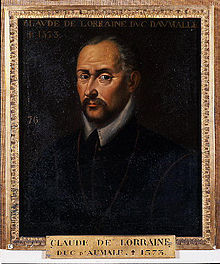
The French Wars of Religion were a series of civil wars between French Catholics and Protestants from 1562 to 1598. Between two and four million people died from violence, famine or disease directly caused by the conflict, and it severely damaged the power of the French monarchy. One of its most notorious episodes was the St. Bartholomew's Day massacre in 1572. The fighting ended with a compromise in 1598, when Henry of Navarre, who had converted to Catholicism in 1593, was proclaimed King Henry IV of France and issued the Edict of Nantes, which granted substantial rights and freedoms to the Huguenots. However, Catholics continued to disapprove of Protestants and of Henry, and his assassination in 1610 triggered a fresh round of Huguenot rebellions in the 1620s.

The House of Guise was a prominent French noble family that was involved heavily in the French Wars of Religion. The House of Guise was the founding house of the Principality of Joinville.
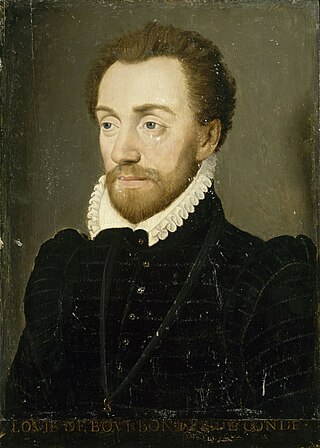
Louis de Bourbon, 1st Prince of Condé was a prominent Huguenot leader and general, the founder of the Condé branch of the House of Bourbon. Coming from a position of relative political unimportance during the reign of Henri II, Condé's support for the Huguenots, along with his leading role in the conspiracy of Amboise and its aftermath, pushed him to the centre of French politics. Arrested during the reign of Francis II then released upon the latter's premature death, he would lead the Huguenot forces in the first three civil wars of the French Wars of Religion before being executed after his defeat at the Battle of Jarnac in 1569.
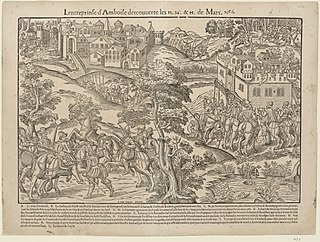
The Amboise conspiracy, also called Tumult of Amboise, was a failed attempt by a Huguenot faction in France to gain control over the young King Francis II and to reverse the policies of the current administration of Francis, Duke of Guise and Charles, Cardinal of Lorraine through their arrest, and potentially execution. Malcontent factions of Huguenots had been chafing under the French crown since the reign of Henry II and with the arrival of a new young king, saw their chance to take power for themselves. However the plot was uncovered ahead of time, and the Guise were ready for them. As such hundreds would be arrested, and many killed. Louis I, Prince of Condé was suspected of involvement, however he was able to flee south, and it was only after some months that the Guise were able to put him on trial. Shortly thereafter, the sickly Francis II died, their hold on the administration collapsed, and with it the conviction of Condé. This tumult would be one of the key steps in the collapse of crown authority that led to the first French War of Religion.

The Edict of Saint-Germain, also known as the Edict of January, was a landmark decree of tolerance promulgated by the regent of France, Catherine de' Medici, in January 1562. The edict provided limited tolerance to the Protestant Huguenots in the Catholic realm, though with counterweighing restrictions on their behaviour. The act represented the culmination of several years of slowly liberalising edicts which had begun with the 1560 Edict of Amboise. After two months the Paris Parlement would be compelled to register it by the rapidly deteriorating situation in the capital. The practical impact of the edict would be highly limited by the subsequent outbreak of the first French Wars of Religion but it would form the foundation for subsequent toleration edicts as the Edict of Nantes of 1598.

The Peace of Saint-Germain-en-Laye was signed on 8 August 1570 by Charles IX of France, Gaspard II de Coligny and Jeanne d'Albret, and ended the 1568 to 1570 Third Civil War, part of the French Wars of Religion.

The Edict of Amboise, also known as the Edict of Pacification, was signed at the Château of Amboise on 19 March 1563 by Catherine de' Medici, acting as regent for her son Charles IX of France. The Edict ended the first stage of the French Wars of Religion, inaugurating a period of official peace in France by guaranteeing the Huguenots religious privileges and freedoms. However, it was gradually undermined by continuing religious violence at a regional level and hostilities renewed in 1567.
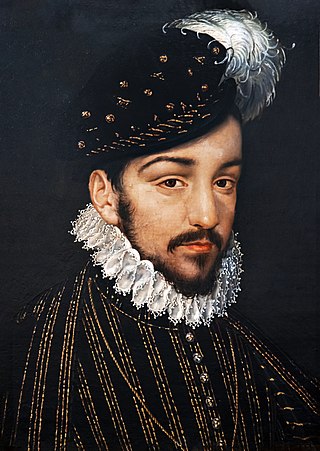
The Peace of Longjumeau was signed on 23 March 1568 by Charles IX of France and Catherine de' Medici. The edict brought to an end the brief second French Wars of Religion with terms that largely confirmed those of the prior edict of Amboise. Unlike the previous edict it would not be sent to the Parlements to examine prior to its publication, due to what the crown had felt was obstructionism the last time. The edict would not however last, and it would be overturned later in the year, being replaced by the Edict of Saint-Maur which outlawed Protestantism at the beginning of the third war of religion.
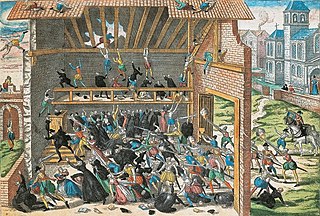
The Massacre of Vassy was the murder of Huguenot worshippers and citizens in an armed action by troops of the Duke of Guise, in Wassy, France on 1 March 1562. The massacre is identified as the first major event in the French Wars of Religion. The series of battles that followed concluded in the signing of the Peace of Amboise on 19 March 1563.

Charles de Bourbon, known as the Cardinal de Bourbon, was a French noble and prelate. He was the Archbishop of Rouen from 1550 and the Catholic Ligue candidate for King of France from 1589.

Charles de Bourbon, Prince de la Roche-sur-Yon,, was a Prince of the Blood and provincial governor under three French kings. He fought in the latter Italian wars during the reign of Henri II, commanding an army during the 1554 campaign into the Spanish Netherlands.

The siege of Orléans was the final key military engagement of the first French War of Religion. Having lost the Battle of Dreux the rebel Huguenots fell back with their remaining forces to the city. François, Duke of Guise, the only non captive royal commander, moved to lay siege to the town, hoping its capitulation would bring about a total victory for the crowns forces. However, despite reducing the suburbs, he would be assassinated at the siege before he could bring it to a conclusion. As a result the captive Louis, Prince of Condé and Anne de Montmorency at Catherine de' Medici's direction were able to negotiate a compromise end to the first war in the Edict of Amboise.

On 24 February 1563, François, Duke of Guise was assassinated by the Huguenot Jean de Poltrot during the Siege of Orléans. His death represents a critical turning point in the French Wars of Religion. It would be the first major assassination in what would become a blood feud between the various aristocratic houses which would see the deaths of Louis, Prince of Condé and the St. Bartholomew's Day massacre follow. It also proved a decisive factor in bringing the first War of Religion to a close in the Edict of Amboise.

The St. Bartholomew's Day massacre in the provinces refers to a series of killings that took place in towns across France between August and October 1572. A reaction to news of the St. Bartholomew's Day massacre in Paris, total deaths are estimated as between 3,000 and 5,000, roughly equivalent to those incurred in Paris. These events severely impacted Huguenot communities outside their strongholds in Southern France; the deaths combined with fear and distrust of Catholic intentions resulted in a large wave of conversions, while many others went into exile.

The Edict of July, also known as the first Edict of Saint-Germain was a decree of limited tolerance promulgated by the regent of France, Catherine de' Medici, in July 1561. Whilst it emphasised a continued commitment to banning Huguenot worship in France, it granted pardon for all religious offenses since the reign of Henry II, who had died two years earlier, which was a victory for the Protestant community. A further Protestant victory was in the reaffirmation of the removal of the death penalty for heresy cases. The edict would be overtaken by events, and ultimately left unenforced as France moved first to the landmark Edict of Saint-Germain and then into the Wars of Religion.
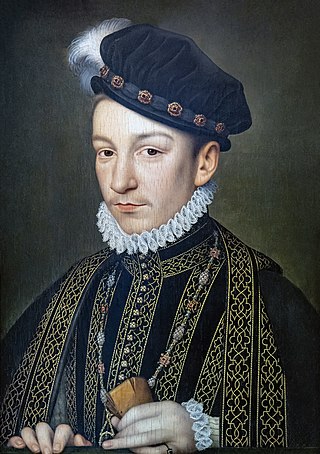
The Edict of Saint-Maur was a prohibitive religious edict, promulgated by Charles IX of France at the outbreak of the third war of religion. The edict revoked the tolerance that had been granted to Protestantism, in the edicts of Saint-Germain, Amboise and the peace of Longjumeau. The edict forbade the exercise of any religion other than Catholicism in the kingdom of France, and gave Protestants 15 days to vacate the kingdom. Ultimately the edict would be overturned in the landmark peace of Saint-Germain-en-Laye at the end of the third religious war in 1570 which restored recognition to Protestantism, alongside many other concessions.

The Edict of Amboise (1560) was a decree that created the framework to separate heresy from sedition, promulgated by the young king Francis II on the advice of his council and mother Catherine de' Medici. The edict was the first promulgated in France that lessened the persecution of Huguenots through the provision of amnesty for past religious crimes on the condition the offender returned to the Catholic fold. The edict was published during the Amboise conspiracy whilst the royal court was resident in the Château d'Amboise and their authority over France was shaken. It would be superseded first by the Edict of Romorantin in May of the same year, then the Edict of July and finally the Edict of Saint-Germain
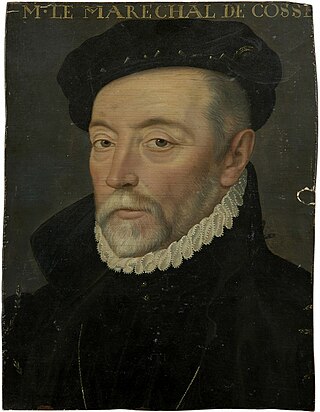
Artus de Cossé, seigneur de Gonnor and Comte de Secondigny (1512–1582), was a Marshal of France, an office he was elevated to in 1567. He served to administer the armies finances during the first of the French Wars of Religion and would lead the royal army in its pursuit of the Prince of Condé during the second civil war. His failure to catch the army led to his dismissal from overall royal command. During the third civil war he would again lead troops, beating a small Protestant force, before being defeated in the final days of the war at Arney-le-Duc. His long history of Politique leanings would push him into the orbit of the Malcontents for which he would be arrested in 1574. In 1576 he would be released and restored to favour before he died in 1582.

Antoine III de Croÿ, Prince de Porcien (1540-1567) was a French noble and Protestant rebel. Porcien, who held the rank of prince through his sovereign possessions, was a member of the Croÿ family. In 1558 his mother converted to Protestantism, and he followed her in 1560. His house, de Croÿ had been close with the Guise who used them as part of their broader rivalry with the House of Montmorency, supporting their claims that hurt their rival. Porcien broke with the Guise after his conversion. With the advent of Francis II's reign he joined Navarre in opposition to their house. The following year a strategic marriage was arranged for him with Catherine de Clèves which would bring him the County of Eu in 1564.

Henri-Robert de La Marck was a French noble, sovereign prince and governor of Normandy. Ascending to the high office of governor of Normandy on the death of his father shortly after his return from captivity, Bouillon found himself in financial trouble, ruined by the debt from his father’s ransom. With the death of Henri II in 1559 and the disgrace of his patron Diane de Poitiers Bouillon found his position in Normandy tenuous. Bouillon converted to Protestantism in 1561, as much of the Norman nobility had in the prior years, Bouillon however had little interest in leading them.

